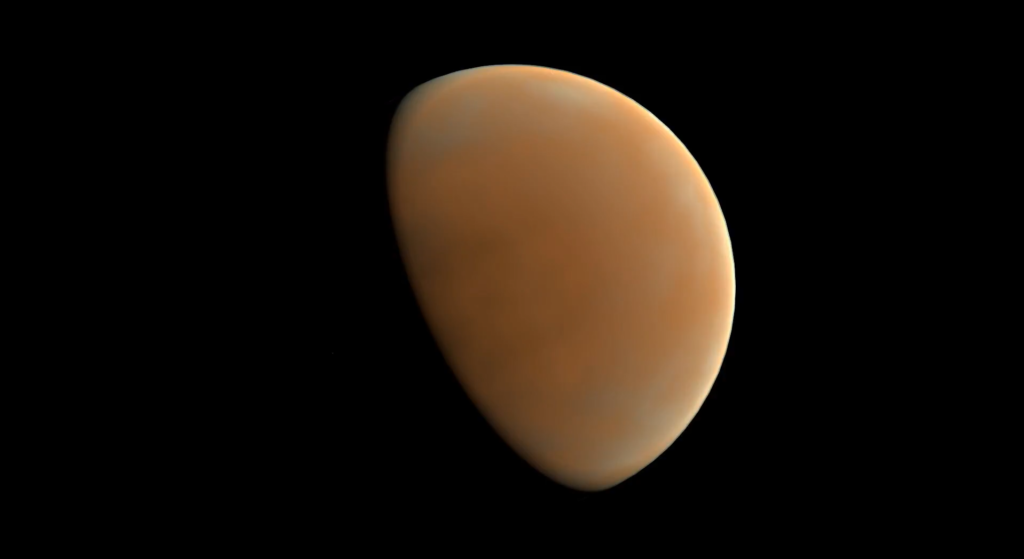Venus
Our Closest Neighbor
Venus is the closest planet to Earth that people often mistakenly identify as a star. Yes, many people look up at the sky and think Venus is a star. That’s because of its great mgnitude. It is the third most noticeable orb in the sky after the sun and our moon.
Indeed, Venus is a magnificent planet, often called Earth’s twin. Buckle up and join us as we delve into the mysteries and wonders of our twin planet!
Known for its captivating beauty, Venus has fascinated astronomers and scientists for centuries. It’s roughly the same size as Earth. However, don’t let its similarity fool you; Venus has a completely different climate and environment.

Still grab from animation by J.J. Del Mar
Atmosphere
Venus is a prime example of a hostile planet. Its atmosphere is predominantly composed of carbon dioxide, with thick clouds of sulfuric acid. These clouds create a runaway greenhouse effect, trapping heat and causing extreme temperatures.
Surface temperatures on Venus can soar up to a scorching 900 degrees Fahrenheit (475 degrees Celsius), making it the hottest planet in our solar system; hotter than even Mercury, which is closer to the Sun.
Images of the atmosphere of Venus taken by the Mariner 10 probe show a light brown or tan upper layer with some patches of white. The atmosphere is so thick that it does not allow us to see the surface of the planet.
The atmosphere of Venus is not just dense but blisteringly hot; around 92 times the pressure of Earth’s atmosphere at sea level. The air pressure on Venus is so intense that it would crush most of the equipment we use on Earth.
More about its clouds
Now, let’s talk about those mesmerizing clouds. They are made up of droplets of sulfuric acid, creating a picturesque but treacherous landscape. The clouds reflect sunlight, giving Venus its dazzling appearance as the “Evening Star” or the “Morning Star.”
Atmosphere In Visible Light
The following animation does show Venus in its visible light. The animation is fully CGI and no NASA global maps of the planet were used. Other animations of the planet’s atmosphere on the web show the thick layers in the ultraviolet spectrum of light as taken by NASA’s Pioneer orbiter and not its visible colors.
Rotation
Venus rotates on its axis very slowly—about once every 243 Earth days. But here’s an interesting twist: The planet has a retrograde rotation, meaning it spins in the opposite direction of most other planets in our solar system. It’s one of the many mysteries surrounding this captivating celestial body.
Exploration
Despite its harsh conditions, scientists have made incredible efforts to explore Venus. Numerous space probes, such as the Soviet Union’s Venera and the United States’ Magellan, have provided us with valuable data and stunning images. These missions have allowed us to better understand the secrets hidden within the planet’s thick atmosphere and uncover clues about its geological history.
Surface
Venus is an eruption wonderland with thousands of volcanoes scattered across its surface. One of its most notable features is the Maxwell Montes, the planet’s highest mountain, reaching about 12.4 miles high (20 kilometers). These volcanic activities have played a significant role in shaping the planet’s geology and contribute to its intense atmosphere.
Venus Surface Real Colors
The texture image was taken from the mapping done by the NASA / USGS Magellan probe and the color was composed after the USSR Soviet era Venera probe returned images of the surface of the planet. The real color is a brownish / dark orange surface. The images were then reprocessed to remove reddish colors and enhance brown ones. This is an approximation to what the human eye would see looking at Venus and standing on its surface.
[The exaggerated golden / orange models found on the web were rendered after an artist’s coloring of the surface. However, the photographs by the Soviet-era Venera probe suggest a brownish color as it would be seen by the human eye, and not a golden / orange surface.]
Well, folks, that concludes our exhilarating journey to Venus, a planet that showcases the extremes of our solar system. Its beauty, hostile environment, and scientific mysteries make it an intriguing destination for future exploration.
Until next time, keep exploring the wonders of the universe!
Don’t forget to like, comment, and subscribe to our YouTube channel.
Acknowledgements
NASA / USGS Magellan mission
ESA
Venera missions
Thanks to JJ Del Mar for his contribution to this page.
#Venus media made possible by WL Media USA
© 2024 Rediscovered Astronomy
